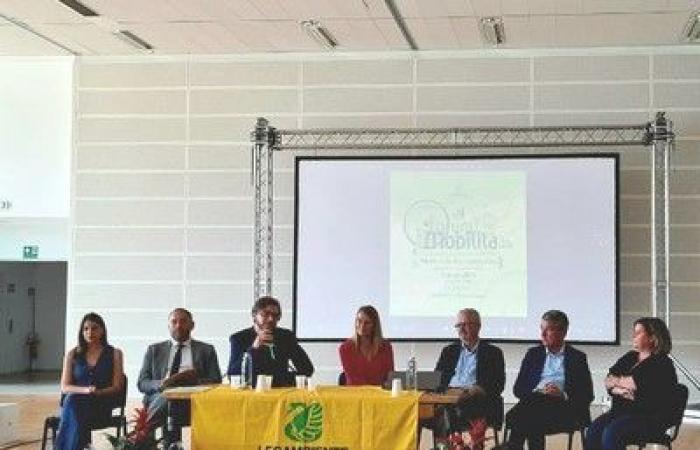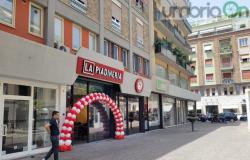On 14 June 2024, at the auditorium of the Roy Rogers Center in Scandicci, Legambiente Toscana organized the first forum on sustainable mobility in our region with the aim of taking stock of the sustainable mobility of people and goods in Tuscany.
The forum was divided into three sessions:
- rethinking the city in the management of urban times and spaces. Road safety, air quality and quality of life
- electrify and streamline mobility to accelerate the energy transaction
- synergies in public transport, intermodal hubs and the role of sharing mobility.
This last session took the form of a round table in which a large group of representatives from public transport, politics and trade unions took part.
Mobility is central to everyone’s life, for this reason, when we move, we must be aware that transport is responsible for 30% of climate-changing emissions and has a strong impact on noise and air pollution, especially in urban areas, with an impact on health and personal well-being. In fact, it is now clear that environmental pollution, as well as climate change, worsen the quality of life.
Give up unnecessary travel and opt, as much as possible, for sustainable mobility
- contributes to mitigating climate change at a local level and counteracting the heat island effect in hot periods
- improves air quality, reducing noise and air pollution with benefits also for human health.
The data available provide us with a disheartening picture, the mobility habits in our region, but also in our country, are not changing, as indicated by the 20th Isfort report on mobility and the MobilitAria 2024 report goes in the same direction, which observes how the car is still at the center of travel in Italy, despite the fact that many pathologies can also be traced back to the poor or terrible quality of the air we breathe.
To abandon the car, especially in urban areas, and opt for sustainable mobility, on foot, by bicycle or with less impactful means, it is necessary rethink cities as illustrated in their speeches by Andrea Colombo, Project Manager “Bologna Città 30”, and Francesco Alberti, professor of Urban Planning and Mobility Manager of UNIFI.
Città 30 is much more than a simple speed limit, it is a driving force for a policy of new road rules but also, and above all, it represents the desire to redesign cities with the support of public communication and community engagement without which real change and greener, fairer and safer cities cannot be achieved.
City 30 is a community-supported political project. Since January 2024, this idea has become reality in Bologna, opening a national debate on the right to road safety, sustainable mobility and public space for all in cities. The challenge of sustainability, climate neutrality and road safety in the city is closely linked to the aspiration for a better quality of life for all citizens, recalls Andrea Colombo. Safety on the roads is an important example, in fact the data says that 73% of accidents occur in the city due to high speed, if we want to seriously address this critical issue, we need to lower the speed of vehicles in urban areas to 30 km/h , as recommended by the World Health Organization (WHO).
This is a cultural, behavioral change: new styles of behavior in driving and in mobility and infrastructural choices, which require strong communication aimed at creating consensus and involvement of citizens.
Francesco Alberti of the University of Florence highlights that, in the relationship between urban space and mobility choices, we are faced with a paradigm shift that can no longer be postponed.
The green deal The European Union, recalls the professor, predicts that climate neutrality in cities will be achieved by 2050, but to achieve the objective, atmospheric emissions produced by the transport sector must be reduced by 90%. Unfortunately, road transport is lagging behind this goal.
The European motorization index (number of vehicles in relation to the number of inhabitants: 562 cars per 1000 inhabitants) is very high, demonstrating that car transport represents a major critical issue. Italy, then, is the country in Europe with the highest motorization rate (+21%), Tuscany has an even higher rate than that recorded at national level (+8%) and the metropolitan city has a even greater while the municipality of Florence, thanks to some policies adopted, has reduced the motorization rate below the European average.
The latest ISFORT report highlights that travel, in our country, is between approximately 2 and 10 km in approximately 50% of cases. In the metropolitan city of Florence, with a very high rate of motorization, 50% of the journeys are under 5 km, in the city of Florence 60% are actually under 5 km. These are distances for which the use of the car, in addition to having an impact, is unreasonable, for example from a time point of view, as traveling 4/5 km by bicycle is faster than by car. According to Professor Alberti, it is necessary to influence journeys of less than 5 km, ensuring that the car is abandoned for short journeys in favor of other more sustainable means or, even better, in favor of gentle mobility on foot.
Removing cars and heavy vehicles from city streets also means freeing up space, making urban areas more liveable but also more beautiful and usable for citizens. This benefit can only be achieved through political choices, which tend, first of all, to eliminate unnecessary travelfor example by implementing smart working for all white-collar jobs.
For the portion of trips that cannot be eliminated, however, it is necessary to provide a second step (shift), which involves the sustainability option, preferring a mix of travel choices made of local public transport, soft mobility, sharing and much more.
Finally, the last step of the change (improve) points to the improvement of vehicle performance and/or electric mobility. It is wrong to think of changing mobility only with the massive introduction of electric cars on our roads.
Many cities in Europe and some in Italy are planning the change by following the steps indicated above with good results thanks also to the support of citizens who are increasingly aware of the need for greater well-being, a good quality of life, more health protection and a healthy environment in the city.






